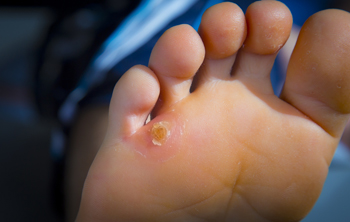 After standing or walking for a significant amount of time, areas of the feet’s skin begin to thicken as a protective measure that allows them to withstand pressure. These thicker areas of skin form corns or calluses, which specifically protect the skin when it rubs against the ground, a shoe, or a bone. Footwear that doesn’t fit correctly, a bone deformity, or a poor walking style can lead to calluses, which are larger hardened areas of skin that don’t have a regular shape. Corns, on the other hand, tend to be much smaller and have a central core. There are 5 types of corns that are likely to form. These include hard corns, seed corns, vascular corns, fibrous corns, and soft corns. Each of these corns can have a different effect on the feet. If corns or calluses are pestering your feet, it is a good idea to consult a podiatrist who can help uncover the reasons behind them and suggest treatment options.
After standing or walking for a significant amount of time, areas of the feet’s skin begin to thicken as a protective measure that allows them to withstand pressure. These thicker areas of skin form corns or calluses, which specifically protect the skin when it rubs against the ground, a shoe, or a bone. Footwear that doesn’t fit correctly, a bone deformity, or a poor walking style can lead to calluses, which are larger hardened areas of skin that don’t have a regular shape. Corns, on the other hand, tend to be much smaller and have a central core. There are 5 types of corns that are likely to form. These include hard corns, seed corns, vascular corns, fibrous corns, and soft corns. Each of these corns can have a different effect on the feet. If corns or calluses are pestering your feet, it is a good idea to consult a podiatrist who can help uncover the reasons behind them and suggest treatment options.
If you have any concerns regarding your feet and ankles, contact Howard Kimmel, DPM of Buckeye Foot Care. Our doctor will treat your foot and ankle needs.
Corns: What Are They? and How Do You Get Rid of Them?
Corns can be described as areas of the skin that have thickened to the point of becoming painful or irritating. They are often layers and layers of the skin that have become dry and rough, and are normally smaller than calluses.
Ways to Prevent Corns
There are many ways to get rid of painful corns such as wearing:
- Well-fitting socks
- Comfortable shoes that are not tight around your foot
- Shoes that offer support
Treating Corns
Treatment of corns involves removing the dead skin that has built up in the specific area of the foot. Consult with Our doctor to determine the best treatment option for your case of corns.
If you have any questions please feel free to contact one of our offices located in Brook Park and Willoughby, OH . We offer the newest diagnostic and treatment technologies for all your foot and ankle needs.
